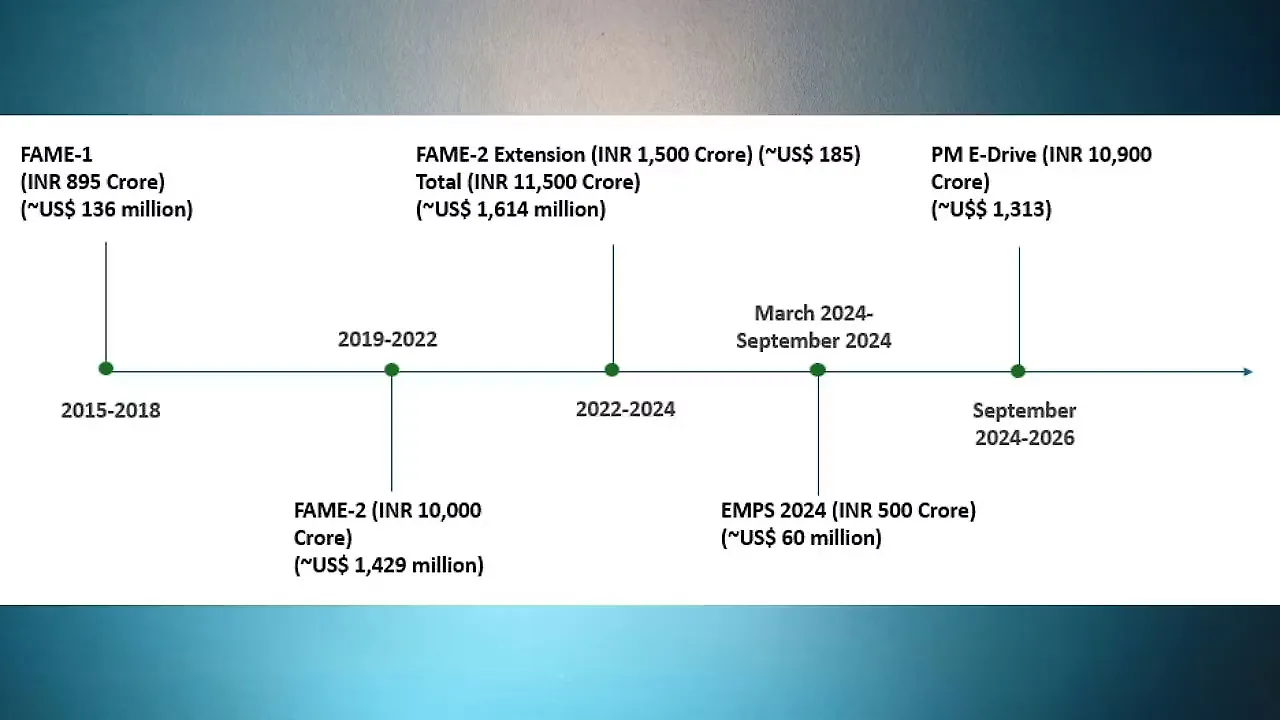
In a step towards a cleaner and more sustainable future, the Government of India has unveiled the PM Electric Drive Revolution in Innovative Vehicle Enhancement (PM E-Drive) scheme.
Spearheaded by the Ministry of Heavy Industries, this initiative signals a significant shift in the country’s approach to electric mobility, following the expiration of the FAME (Faster Adoption and Manufacturing of Electric Vehicles) scheme. With a budget of INR 10,900 crore spread over the next two years, the PM E-Drive scheme is set to catalyse the adoption of electric vehicles (EVs) across multiple sectors, from personal transport to public services.
A Comprehensive Push For Electric Mobility
The PM E-Drive scheme takes a holistic approach, focusing on key vehicle segments like electric two-wheelers (E2Ws), three-wheelers (E3Ws), electric trucks, buses, and even e-ambulances. It also allocates significant resources to building a nationwide charging infrastructure, with the goal of installing 72,300 EV charging stations to support the burgeoning EV ecosystem.
Key Highlights
Subsidy Realignment for Two-Wheelers and Three-Wheelers
Under the new scheme, subsidies for electric two-wheelers (E2Ws), which dominate India's EV market, have been reduced from the allocation in FAME II. The budget for E2W subsidies now stands at INR 3,679 crore, a notable drop from the INR 5,000 crore earmarked under FAME II. This new budget also covers electric three-wheelers (E3Ws), highlighting the government’s effort to push for broader EV adoption across multiple segments. However, subsidies for passenger electric cars and commercial electric vehicles have been excluded in this new framework.
Electric Trucks: A Landmark Inclusion
One of the most groundbreaking additions to the PM E-Drive scheme is the inclusion of electric trucks. This marks the first time that subsidies have been extended to the electric truck segment, which has long been seen as a major contributor to pollution. With INR 500 crore allocated for electric truck subsidies, the government aims to support manufacturers in their transition to cleaner, more efficient heavy vehicles.
E-Ambulances: A New Frontier in Healthcare Mobility
The scheme introduces e-ambulances as a key focus area, with INR 500 crore allocated to their development and deployment. This initiative, aimed at providing greener and more efficient healthcare transport, will set performance and safety standards in collaboration with the Ministry of Health and Family Welfare (MoHFW) and the Ministry of Road Transport and Highways (MoRTH). E-ambulances promise a more comfortable and environmentally friendly alternative to conventional models.
Aadhaar-Based E-Voucher System for Subsidy Transparency
In an effort to enhance transparency and accountability, the PM E-Drive scheme introduces an Aadhaar-based e-voucher system for subsidies. This system ensures that each eligible EV buyer receives a digital voucher authenticated by Aadhaar, which is submitted to the dealer and uploaded to the PM E-Drive portal. This move aims to address the issues of subsidy misappropriation seen under FAME II, streamlining the process for both consumers and manufacturers.

Public Transport & Charging Infrastructure - The Backbone
The PM E-Drive scheme goes beyond individual vehicle ownership, placing a strong emphasis on public transport and the expansion of EV charging infrastructure.
Electric Buses For Cleaner Cities
A significant portion of the PM E-Drive budget—INR 4,391 crore—has been allocated for the procurement of 14,028 electric buses for state transport undertakings (STUs) and public transport agencies. This move aligns with the government’s mission to reduce urban pollution by transitioning public bus fleets to electric power, offering a more sustainable solution for mass transit.
Boosting Charging Infrastructure
To overcome one of the biggest barriers to EV adoption—limited charging availability—the scheme dedicates INR 2,000 crore towards expanding the EV charging network. By supporting the installation of 72,300 fast chargers for a variety of vehicles, including two-wheelers, three-wheelers, four-wheelers, and buses, the government aims to make EV charging accessible in urban centers and along highways, benefiting both individual owners and public transport systems.
A Strategic Shift Towards a Sustainable Future
The PM E-Drive initiative represents a pivotal moment in India’s electric vehicle revolution. By shifting focus from subsidies for personal electric cars to public transport, electric trucks, and infrastructure, the government is laying the foundation for widespread EV adoption. This targeted approach reflects a broader vision of sustainable urbanization, tackling pollution where it matters most—on the roads.
With the inclusion of electric trucks and e-ambulances, the scheme addresses critical sectors often overlooked in the push for clean energy. At the same time, the increased focus on charging infrastructure signals a recognition that a robust EV ecosystem is essential for long-term success.
Conclusion
As India continues its journey towards electric mobility, the PM E-Drive scheme stands as a testament to the government's commitment to addressing both environmental and infrastructural challenges. By promoting electric public transport, enhancing charging infrastructure, and ensuring transparency in subsidies, the scheme is set to drive a new wave of innovation and efficiency in the EV market. With strategic investments and a future-forward approach, India is positioning itself as a global leader in the electric mobility revolution.
Source: JKM Research.
Also Read:
FAME 2 Subsidies To End on 31 March; EV Prices Likely To Increase Drastically